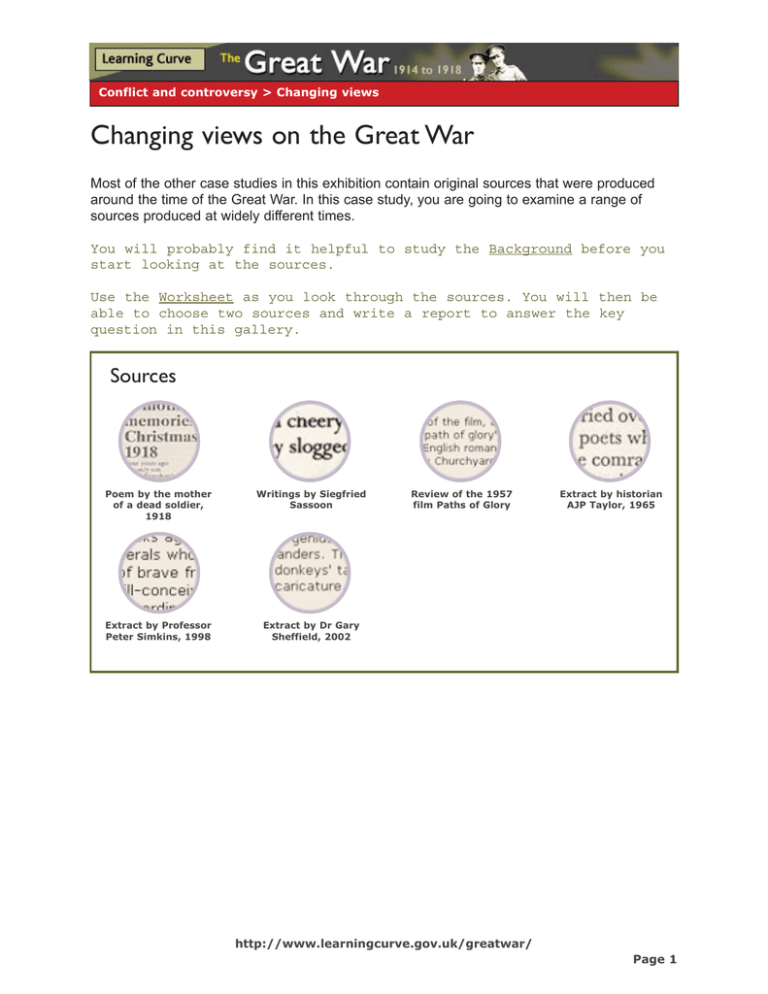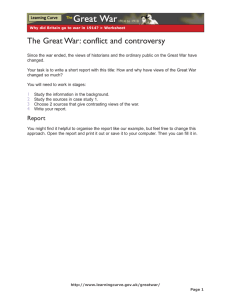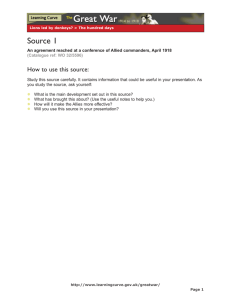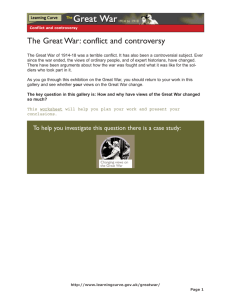Changing views on the Great War
advertisement

Conflict and controversy > Changing views Changing views on the Great War Most of the other case studies in this exhibition contain original sources that were produced around the time of the Great War. In this case study, you are going to examine a range of sources produced at widely different times. You will probably find it helpful to study the Background before you start looking at the sources. Use the Worksheet as you look through the sources. You will then be able to choose two sources and write a report to answer the key question in this gallery. Sources Poem by the mother of a dead soldier, 1918 Writings by Siegfried Sassoon Extract by Professor Peter Simkins, 1998 Extract by Dr Gary Sheffield, 2002 Review of the 1957 film Paths of Glory Extract by historian AJP Taylor, 1965 http://www.learningcurve.gov.uk/greatwar/ Page 1 Conflict and controversy > Changing views Source 1 A poem written by the mother of a soldier killed in the Great War, 1918 (By courtesy of the Staffordshire Newsletter, 6 November 2003) How to use this source: Study this source carefully and see what it tells you about views on the war at the time it was written. As you study the source, ask yourself: z z z z z z What words or phrases could you use to sum up the tone of this poem? Does this poem suggest the war was pointless? Does the mother who wrote this poem think her son died for no reason? Does the poem mention officers or commanders? Who is mentioned? Will you choose this as one of the sources to use in your report? http://www.learningcurve.gov.uk/greatwar/ Page 2 Conflict and controversy > Changing views Source 1 http://www.learningcurve.gov.uk/greatwar/ Page 3 Conflict and controversy > Changing views Source 2 Writings by the war poet, Siegfried Sassoon, published between 1918 and 1938 (Courtesy of Faber and Faber. 2a is from 'The War Poems', 1983. 2b is from 'Complete Memoirs of George Sherston', 1937) 2a 2b How to use this source: Study this source carefully and see what it tells you about views on the war at the time it was written. As you study the source, ask yourself: z z z z What is the tone of source 2a towards the ordinary soldiers? What is the attitude in this source towards the commanders? Study source 2b. How does the author feel about the war at this point in time? Will you choose these as one of the sources to use in your report? http://www.learningcurve.gov.uk/greatwar/ Page 4 Conflict and controversy > Changing views Source 2a http://www.learningcurve.gov.uk/greatwar/ Page 5 Conflict and controversy > Changing views Source 2b http://www.learningcurve.gov.uk/greatwar/ Page 6 Conflict and controversy > Changing views Source 3 Extracts from a website review of the film ‘Paths of Glory’, which was originally shown in 1957 (www.filmsite.org, review by Tim Dirks) How to use this source: Study this source carefully and see what it tells you about views on the war at the time it was written. As you study the source, ask yourself: z z z z z When was this film produced? What is the attitude of this film towards the Great War commanders? How and why was it controversial? Which of sources 1, 2, 4 or 5 is it most similar to? Will you choose this as one of the sources to use in your report? http://www.learningcurve.gov.uk/greatwar/ Page 7 Conflict and controversy > Changing views Source 3 Paths of Glory (1957) is a masterful, unsentimental, classic anti-war film about World War I. It was 28 year-old Stanley Kubrick's fourth feature-length film… Juxtaposed in interesting fashion, this low-budget, independent production with a distinctly European flavor premiered one week after the release of David Lean's Best Picture-winning, CinemaScopic war epic blockbuster, The Bridge on the River Kwai (1957) from Columbia Pictures. This stark, slightly stagey, 87-minute black and white film, shot on location in Germany with crisp B/W photography (by George Krause) with a budget less than $1 million, is as compelling and harsh an indictment and criticism of war as Lewis Milestone's award-winning, anti-war classic All Quiet On The Western Front (1930), adapted from Erich Maria Remarque's novel. The title of the film, actually ironic and inappropriate since war is not a 'path of glory', was suggested by line 36 in 18th century English romantic poet Thomas Gray's Elegy Written in a Country Churchyard: The paths of glory lead but to the grave. Although the film is considered one of Kubrick's best, it was denied even a single Academy Award nomination. The suicidal attack on an impregnable fortress named 'Ant Hill' in the film (against an unseen German enemy) was inspired by and loosely based upon the six-month bloodbath in 1916 during the Battle of Verdun for Fort Douamont, a French stronghold eventually captured by the Germans. (The same battle was frequently referred to in Renoir's The Grand Illusion (1937)). The protracted conflict claimed the lives of 315,000 French soldiers (called poilus) on the Western front. Due to the film's raw, controversially-offensive and critical assessment of hypocritical French military and bureaucratic authorities who callously condemn and sacrifice three randomly-chosen innocent men with execution (for cowardice) for their own fatal blunder, it suffered poor box-office returns, and was banned in France and Switzerland for almost twenty years (until the mid-1970s) following its release. One of the film's posters exclaimed: "IT EXPLODES IN THE NO-MAN'S LAND NO PICTURE EVER DARED CROSS BEFORE!" It also describes the film as a "bombshell story of a Colonel who led his regiment into hell and back - while their maddened General waited for them - with a firing squad." Major star Kirk Douglas … played the lead role as lawyer-trained Colonel Dax compelled to defend three of his court-martialed men against hopeless odds. … Based upon the controversial, published, semi-fictional 1935 novel of the same name by Humphrey Cobb, this anti-war film emphasizes the wide, hierarchical gap between those who take orders and fight the wars in muddy trenches, and those that give the orders and are isolated from the real ravages of war. Three blameless, subordinate soldiers are victimized, given hopeless 'paths of glory,' and condemned to die to cover up the wrong-headed actions of their ruthless and opportunistic superiors. … [To read the full review and summary of the film, go to: http://www.filmsite.org/path.html] http://www.learningcurve.gov.uk/greatwar/ Page 8 Conflict and controversy > Changing views Source 4 Extract from 'English History 1914-1945' by the historian, AJP Taylor, published in 1965 (Page 61-2, by permission of Oxford University Press) 4a 4b How to use this source: Study this source carefully and see what it tells you about views on the war at the time it was written. As you study the source, ask yourself: z Is this source critical of the Great War commanders? z Is this source more balanced than sources 2-3? z Will you choose this as one of the sources to use in your report? http://www.learningcurve.gov.uk/greatwar/ Page 9 Conflict and controversy > Changing views Source 4a http://www.learningcurve.gov.uk/greatwar/ Page 10 Conflict and controversy > Changing views Source 4b http://www.learningcurve.gov.uk/greatwar/ Page 11 Conflict and controversy > Changing views Source 5 Extract from an article called ‘Lions Led By Donkeys?’ by Professor Peter Simkins, 1998 (Courtesy of the BBC) How to use this source: Study this source carefully and see what it tells you about views on the war at the time it was written. As you study the source, ask yourself: z z z z z Would you say this source presents a balanced view? Which of sources 1-4 does it most agree with? Which of sources 1-4 does it most disagree with? Will you choose this as one of the sources to use in your report? Will you choose this as one of the sources to use in your report? http://www.learningcurve.gov.uk/greatwar/ Page 12 Conflict and controversy > Changing views Source 5 As we approach the 80th anniversary of the armistice that brought the fighting in the Great War to an end, public perceptions of that war - particularly in Britain - are still dominated by images of the Somme and Passchendaele, of futile frontal attacks against machine guns in the mud of Flanders, of generals who were little more than "butchers and bunglers", and of brave front-line troops who were sacrificed because of the ill-conceived plans of incompetent staff officers. In short, ordinary British and Dominion Officers were "lions led by donkeys". The myth of the uncaring general - safely dining and drinking in his chateau while the front-line troops lived and died in squalor - has proved especially durable - and has been reinforced recently by Stephen Fry's portrayal of just such an officer in BBC's Blackadder Goes Forth. What is much less widely known is that 78 British and Dominion officers of the rank of Brigadier General and above died on active service in the First World War while a further 146 were wounded. These figures alone show that, contrary to popular belief, British Generals frequently went close enough to the battle zone to place themselves in considerable danger. Again, whereas the Somme and Passchendaele remain familiar names, the huge successes of the British and Dominion forces under Field Marshal Sir Douglas Haig between 8 August and 11 November 1918 are now largely forgotten by the British public. … If we are prepared to criticise Haig and his army commanders for their mistakes in 1916 and 1917, then it is perhaps only fair that, at the same time, they should receive due credit for their decisive, but forgotten victories in 1918. [To read the full article on the BBC website, go to: http://news.bbc.co.uk/1/hi/special_report/1998/10/98/world_war_i/197586.stm] http://www.learningcurve.gov.uk/greatwar/ Page 13 Conflict and controversy > Changing views Source 6 Extract from an article called ‘Lions Led by Donkeys? The British Army in World War One’ by Dr Gary Sheffield, 2002 (Courtesy of the BBC) How to use this source: Study this source carefully and see what it tells you about views on the war at the time it was written. As you study the source, ask yourself: z z z z z Would you say this source presents a balanced view? Which of sources 1-4 does it most agree with? Which of sources 1-4 does it most disagree with? Are there any areas in which source 6 agrees or disagrees with source 5? Will you choose this as one of the sources to use in your report? http://www.learningcurve.gov.uk/greatwar/ Page 14 Conflict and controversy > Changing views Source 6 Douglas Haig was 'brilliant to the top of his Army boots'. David Lloyd George's view sums up the attitude of many people towards Haig and other British generals of World War One. They were, supposedly, 'donkeys': moustachioed incompetents who sent the 'lions' of the Poor Bloody Infantry to their deaths in futile battles. Many popular books, films and television programmes echo this belief. The casualty list - one million British Empire dead - and the bloody stalemate of the Western Front seem to add credence to this version of events. But there is another interpretation. ... One cannot ignore the appalling waste of human life in World War One. Some of these losses were undoubtedly caused by incompetence. Many more were the result of decisions made by men who, although not incompetent, were like any other human being prone to making mistakes. Haig's decision to continue with the fighting at Passchendaele in 1917 after the opportunity for real gains had passed comes into this category. In some ways the British and other armies might have grasped the potential of technology earlier than they did. During the Somme, Haig and Rawlinson failed to understand the best way of using artillery. Haig, however, was no technophobe. He encouraged the development of advanced weaponry such as tanks, machine guns and aircraft. He, like Rawlinson and a host of other commanders at all levels in the BEF, learned from experience. The result was that by 1918 the British army was second to none in its modernity and military ability. It was led by men who, if not military geniuses, were at least thoroughly competent commanders. The victory in 1918 was the payoff. The 'lions led by donkeys' tag should be dismissed for what it is - a misleading caricature. [To read the full article on the BBC website, go to: http://www.bbc.co.uk/history/war/wwone/lions_donkeys_01.shtml] http://www.learningcurve.gov.uk/greatwar/ Page 15


